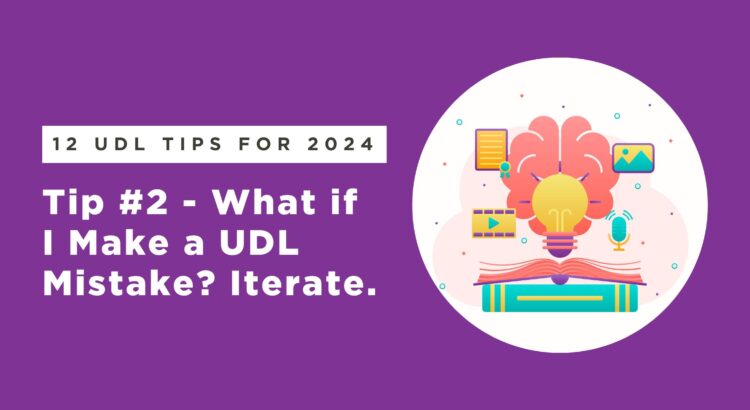Welcome back to the Universal Design for Learning Working Group’s 12 UDL Tips for 2024. You’re already doing a great job at keeping your New Year’s resolution to become a better, more equitable teacher by reading our first blogpost, Tip #1- You’re already doing UDL. Hopefully you have explicitly pointed out the built-in ReadSpeaker text-to-speech tool in your Brightspace course to your students. And remember that overt discussion of the learning process in class isn’t wasting time that you could be covering content. It’s actually helping your students become strategic thinkers and expert learners. Good teachers don’t just teach content; they teach students how to learn.
The next barrier to keeping your 2024 UDL resolution is the fear of trying something new and failing, “What if I make a UDL mistake?” After all, you’re not a UDL expert (yet!) and isn’t there the possibility that the UDL technique that you try out might actually make things worse for student learning if it doesn’t work? Again, you’re in luck because iteration is built into the philosophy of UDL. If you make a mistake, iterate!
Learner Variability
One of the basic cognitive science findings that informs UDL as a framework is the notion of learner variability. Rather than teaching to an imaginary “average student,” the reality is that there is no average or norm because each student learns differently. The efforts that you make to engage any given student necessarily won’t fit all students. That doesn’t mean that the activity or technique that you’re trying out fails. It means that different techniques work well for different learners because of learner variability. UDL expects that you will iterate your course and learning activities to provide multiple means of engagement, representation, and action/expression.
Any post-secondary teacher who has taught a first-year course multiple times has probably had the experience that the topic or activity that worked so well in class last year inexplicably fell flat the next year. The groups of students may not have seemed all that different on the surface, but natural variability in learners is a guarantee that there isn’t a one-size-fits-all teaching tool. Indeed, the notion that there are even fixed “types” of learners has been debunked by researchers in cognitive science. Someone who does well with a visual learning activity at one point in the semester, may not do well with repeated visual learning tasks, let alone “require” a visual context or aid for every learning topic.
Accounting for learner variability in course and learning activity design eases the fear of making a UDL mistake and also the related fear that you have to make visual, audio, text, and hands-on alternatives for everything in your course. UDL expert Tom Tobin’s call to Reach Everyone, Teach Everyone becomes achievable if you understand that iteration is a positive and necessary step in learning design. Teachers naturally try to craft each part of their course to achieve the best outcomes for learning, but in the end, the inclusion of a diversity of approaches is what will work best to reach the broadest variety of learners.
Image by Freepik

